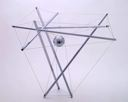R. Buckminster Fuller
American
(Milton, Massachusetts, 1895 - 1983, Los Angeles, California)
Richard Buckminster Fuller, who preferred to be called Bucky, was born in Milton, Massachusetts on July 12, 1895. He spent his youth on Bear Island in Penobscot Bay off the coast of Maine, attended Frobelian kindergarten, Milton Academy, and Harvard University but was expelled from the latter twice—once for wasteful extravagance with a Vaudeville troupe and once for disinterest in his studies. From childhood, he displayed a natural propensity for making things. During college he worked briefly as a mechanic in a textile mill, and during World War I he served as a shipboard radio operator and crash rescue boat commander in the U. S. Navy. He married in 1917 and in the 1920s with his father-in-law established a company producing lightweight weatherproof and fireproof housing but the company went bankrupt. In 1927 his young daughter died from polio and spinal meningitis. Distraught and jobless, he contemplated suicide, but decided instead to undertake "an experiment, to find what a single individual [could] contribute to changing the world and benefiting all humanity.” (1)
The experiment was a success. He went on to write more than 30 books, to earn 28 U. S. patents, to circumnavigate the globe 57 times, to coin the term “Spaceship Earth,” and to teach the world countless ways to apply minimal amounts of mental or physical energy at the appropriate moment to achieve maximum advantageous change. He said, “call me Trim Tab.” That is the tiny adjustable flap on the trailing edge of an ocean liner’s rudder that creates a low pressure area, easing the movement of the relatively small rudder that steers the massive ship.
Fuller is best known for his Dymaxion (short for dynamic maximum tension) house and car, and for popularizing the geodesic dome, an efficient but often leaky structure designed and built through application of the synergistic principle of tensegrity. Tensegrity is the balance of forces of tension (cables) and compression (rods) that the artist patented. That patent, dated 13 Nov. 1962, defines tensegrity as “the physical phenomenon that produces a stable geometric structure with solid members that are arranged in tandem with tense metal cables. The solid members of this system do not touch or support each other directly.”(2)
(1) Design – A Three-Wheel Dream That Died at Takeoff – Buckminster Fuller and the Dymaxion Car – NYTimes.com, cited in Fuller Entry in Wikipedia accessed 10 August 2009.
(2) James Ward, ed., The Artifacts of R. Buckminster Fuller, Volume Four: The Geodesic Revolution, Part 2, 1960-83 (New York: Garland Publishing, 1985), 36 (copy in object file).
Image credit: Dan Lindsay, Buckminster Fuller, 1972–1973, (c) CC-Attribution 3.0 license
American
(Milton, Massachusetts, 1895 - 1983, Los Angeles, California)
Richard Buckminster Fuller, who preferred to be called Bucky, was born in Milton, Massachusetts on July 12, 1895. He spent his youth on Bear Island in Penobscot Bay off the coast of Maine, attended Frobelian kindergarten, Milton Academy, and Harvard University but was expelled from the latter twice—once for wasteful extravagance with a Vaudeville troupe and once for disinterest in his studies. From childhood, he displayed a natural propensity for making things. During college he worked briefly as a mechanic in a textile mill, and during World War I he served as a shipboard radio operator and crash rescue boat commander in the U. S. Navy. He married in 1917 and in the 1920s with his father-in-law established a company producing lightweight weatherproof and fireproof housing but the company went bankrupt. In 1927 his young daughter died from polio and spinal meningitis. Distraught and jobless, he contemplated suicide, but decided instead to undertake "an experiment, to find what a single individual [could] contribute to changing the world and benefiting all humanity.” (1)
The experiment was a success. He went on to write more than 30 books, to earn 28 U. S. patents, to circumnavigate the globe 57 times, to coin the term “Spaceship Earth,” and to teach the world countless ways to apply minimal amounts of mental or physical energy at the appropriate moment to achieve maximum advantageous change. He said, “call me Trim Tab.” That is the tiny adjustable flap on the trailing edge of an ocean liner’s rudder that creates a low pressure area, easing the movement of the relatively small rudder that steers the massive ship.
Fuller is best known for his Dymaxion (short for dynamic maximum tension) house and car, and for popularizing the geodesic dome, an efficient but often leaky structure designed and built through application of the synergistic principle of tensegrity. Tensegrity is the balance of forces of tension (cables) and compression (rods) that the artist patented. That patent, dated 13 Nov. 1962, defines tensegrity as “the physical phenomenon that produces a stable geometric structure with solid members that are arranged in tandem with tense metal cables. The solid members of this system do not touch or support each other directly.”(2)
(1) Design – A Three-Wheel Dream That Died at Takeoff – Buckminster Fuller and the Dymaxion Car – NYTimes.com, cited in Fuller Entry in Wikipedia accessed 10 August 2009.
(2) James Ward, ed., The Artifacts of R. Buckminster Fuller, Volume Four: The Geodesic Revolution, Part 2, 1960-83 (New York: Garland Publishing, 1985), 36 (copy in object file).
Image credit: Dan Lindsay, Buckminster Fuller, 1972–1973, (c) CC-Attribution 3.0 license
Artist Objects
